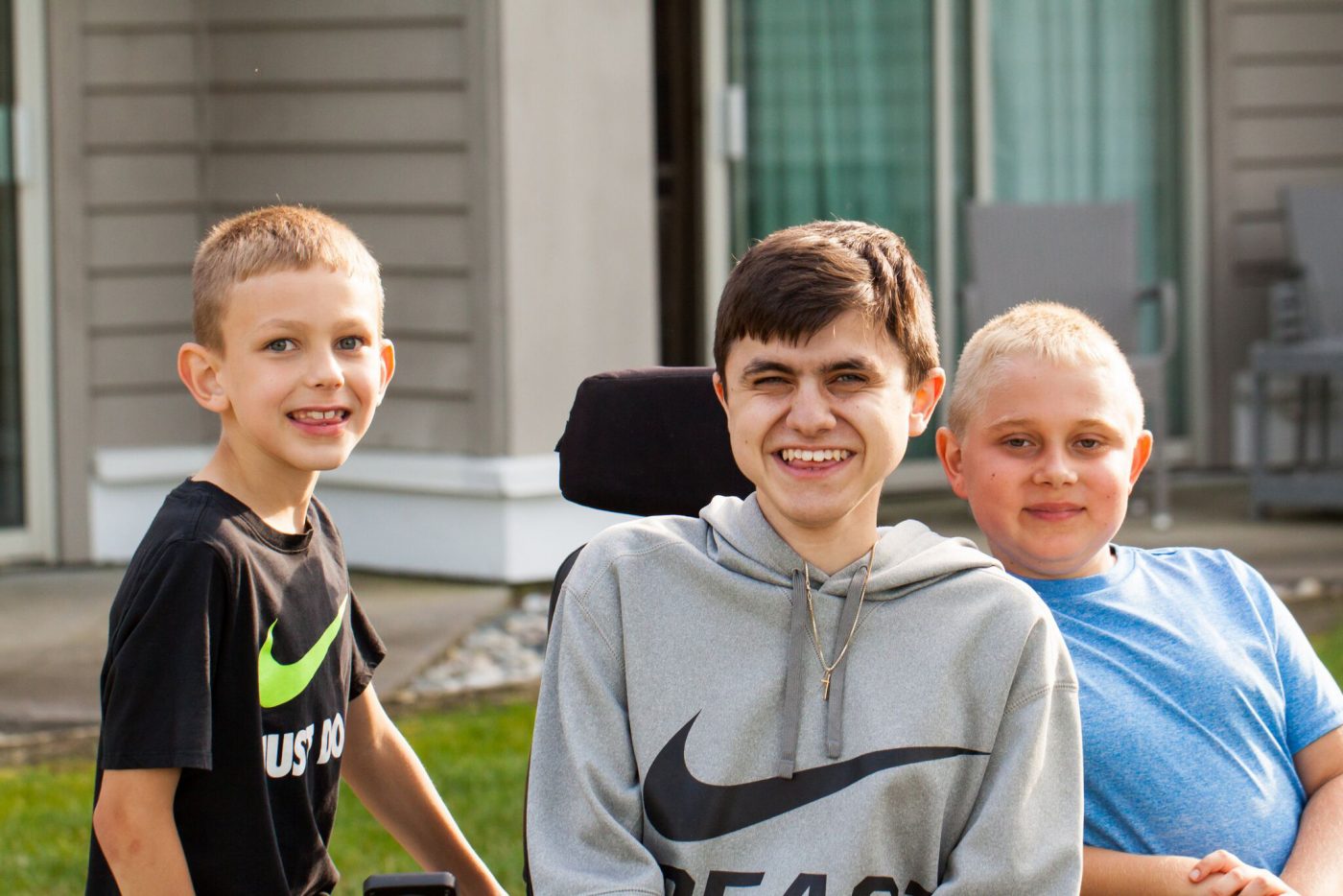CureDuchenne Hosting ‘Futures’ Conference Nov. 3-4 in Boston

Boys with Duchenne muscular dystrophy. (Photo courtesy of CureDuchenne)
One of New England’s top experts in Duchenne muscular dystrophy will give the keynote address at a conference next month dedicated to finding a cure for the neuromuscular disease.
Brenda Wong, MD, is the director of the Duchenne program at University of Massachusetts Medical in Worcester, about a 45-minute drive west of Boston. The Nov. 3-4 event at which she’s speaking — “Futures”— is organized by Cure Duchenne and will take place at the Sheraton Needham Hotel in Needham, a suburb of Boston.
“Futures is going to meet the needs of the community,” Wong said in a press release emailed to Muscular Dystrophy News. “Not only will it cover the latest news in gene therapy and editing, clinical trials and steroid use, but will also offer insightful topics that are important to staying mentally healthy and focused on living your best life for Duchenne patients and caregivers.”
Wong, formerly of Cincinnati Children’s Medical Center, has been treating Duchenne patients for more than 20 years. Under her direction, the new Duchenne program at UMass will provide integrated, interdisciplinary care including cardiology, pulmonology, endocrinology, and orthopedics. It will also serve as a site for multiple clinical trials beginning later this year.
Debra Miller, founder and president of CureDuchenne, said she expects at least 100 people from New England and the mid-Atlantic region to attend next month’s gathering.
“We do 12 workshops a year, but most of our parent conferences are one day, with the goal of reaching out to families that may not be served by major clinics or Duchenne specialists. Futures is a two-day format,” Miller said in a phone interview from CureDuchenne’s headquarters in Newport Beach, California.
CureDuchenne Futures offer patients and caregivers a chance to meet personally with leading scientists, clinicians, and other experts. In addition, adults with Duchenne will talk about how they navigate the disease while staying positive. Also featured is a poster session as well as how-to panels on nutrition, dealing with insurance companies, using steroids, and preserving mobility.
On-site child care is available, with activities for kids including arts and crafts, a gaming lounge, and a photo booth.
The Massachusetts conference is free for all Duchenne patients, families, and caregivers; travel assistance may be available for eligible families. The first 50 to sign up will be entered to win a new Xbox with adaptive controller in a random drawing. To register, click here.
The ‘venture philanthropy’ model
CureDuchenne, launched in 2003, has an annual budget of $5 million and employs 15 people. Miller said her organization tends to focus heavily on early-stage research.
“We’re one of the earliest venture philanthropy organizations, so instead of funding academic organizations, for the most part we either fund businesses or create companies. If the project is successful, the profit comes back to us, and we use that to fund future research,” she explained, adding that “a lot of companies that have made it to clinical trials received early funding from CureDuchenne.”
For example, in 2010, the organization gave $250,000 to Sarepta Therapeutics as part of a $3 million grant that also involved another nonprofit — the Virginia-based Foundation to Eradicate Duchenne — as well as Children’s National Medical Center in Washington, D.C.
Sarepta’s Exondys 51 (eteplirsen) won approval from the U.S. Food and Drug Administration in September 2016 for patients with a confirmed mutation of the dystrophin gene amenable to exon 51 skipping. About 13 percent of Duchenne patients have exon 51 skipping mutations.
Other companies that have received funding from CareDuchenne include gene-therapy developer Bamboo Therapeutics, which was acquired by Pfizer for $465 million in 2016; Capricor Therapeutics, which is now conducting a Phase 2 trial (NCT03406780) of its experimental intravenous infusion therapy, CAP-1002; and 4D Molecular Therapeutics, which uses its own platform to invent proprietary gene therapies using adeno-associated virus (AAV) vectors.
In March 2017, CureDuchenne teamed up with molecular biologist Eric Olson, PhD, to form Exonics Therapeutics with $5 million in seed money. The Column Group, a San Francisco venture capital firm, joined in November 2017, pouring $40 million into the new company. John Ripple is the CEO of Exonics, and Olson is the founder and chief science adviser.
Olson is the director of UT Southwestern’s Hamon Center for Regenerative Science and Medicine in Dallas. The new company, based in Cambridge, Massachusetts, will use the CRISPR/Cas9 gene-editing technique known as SingleCut, with the aim of correcting up to 80 percent of the 3,000 mutations that cause Duchenne.
“The community wants therapies that work,” Miller said. “We’ve got three gene therapies in clinical trials for Duchenne. They all seem to be progressing well. My hope is that they all work and get approved. But these big companies like Sarepta or Pfizer are very conservative and not going to talk about results until the first phase is over.”
Duchenne treatments remain costly
While the pricing of therapies isn’t on the agenda at CureDuchenne’s Futures conference, it does remain an issue of concern for many Duchenne patients and their families — not to mention for the 30 million Americans with rare diseases in general.
Sarepta’s Exondys 51, for example, costs around $300,000 a year for a 25-kilogram patient; that translates into $1,600 for a 2 ml vial and $8,000 for a 10 ml vial.
Emflaza (deflazacort), a corticosteroid originally developed by Marathon Pharmaceuticals and later acquired by PTC Therapeutics, won FDA approval in February 2017 to treat Duchenne patients 5 years and older.
Immediately following the acquisition, PTC dropped Marathon’s $89,000 annual price per patient to around $35,000 a year and, like Sarepta, adopted a pricing structure based on a patient’s weight. The label specifies a dose of 0.9 mg of Emflaza per kg of weight each day.
But only boys who weigh no more than 25 kg (about 55 lbs) would pay $35,000 a year. Because steroids cause patients to gain considerable weight, the treatment might cost more than $100,000 annually for older boys weighing as much as 100 kg (220 lbs).
Before Emflaza’s FDA approval, U.S. patients could import generic deflazacort from Canada or Europe for only $1,200 a year.
“I don’t think anybody likes high prices. Among Duchenne families, everybody would like to see lower prices,” Miller said. “But now that a year has gone by, most of the families who wanted to switch over to Emflaza are successfully getting it through their insurance companies. I haven’t heard about too many families continuing to have problems.”
Other options besides Emflaza
Pat Furlong, founding president and CEO of Parent Project Muscular Dystrophy, said in a phone interview that “parents are worried about the cost” of Emflaza as well as “the potential fight they may have on their hands with insurance companies.”
On the other hand, she said, “now that it’s been on the market for a year, more clinicians are prescribing deflazacort rather than prednisone, and we’re learning how to navigate the insurance system in order to access the drug.”
Bruce Ward, an Arkansas father of a 9-year-old boy with Duchenne, insists that cost is always an issue.
Shortly after his son, Gavin, was diagnosed with the disease, Ward said he contacted the family’s insurance provider to ask about covering Emflaza and was told that a special committee would have to be convened first — a process that would take months.
“I called EmflazaCares to learn how to buy it,” he explained in an email. “In that conversation, I asked about paying for Emflaza myself for the months while we were waiting for insurance to cover it. They were not open to the idea of allowing me to pay, and wanted my son to wait for medicine while they argued with his insurance provider. My understanding is that a series of denials would be necessary before I would have any opportunity to pay directly.”
In retrospect, Ward says he’s glad that call sent him back to researching, because he eventually persuaded Gavin’s doctor to prescribe the boy tamoxifen, a $20-a-month medication used to fight breast cancer — “not because tamoxifen is less expensive but because we believe it has greater benefits than Emflaza, with far fewer side effects.”
In the long run, Ward said, “one of the biggest hurdles in access is that when conditional approval and high prices combine with difficulty in proving efficacy, government and private payers are resistant to covering the medication. Many feel that an optimal solution would be to restrict pricing models for medications that cannot qualify for full approval.”







